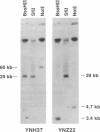Abstract
The Miller-Dieker syndrome (MDS), composed of characteristic facial abnormalities and a severe neuronal migration disorder affecting the cerebral cortex, is caused by visible or submicroscopic deletions of chromosome band 17p13. Twelve anonymous DNA markers were tested against a panel of somatic cell hybrids containing 17p deletions from seven MDS patients. All patients, including three with normal karyotypes, are deleted for a variable set of 5-12 markers. Two highly polymorphic VNTR (variable number of tandem repeats) probes, YNZ22 and YNH37, are codeleted in all patients tested and make molecular diagnosis for this disorder feasible. By pulsed-field gel electrophoresis, YNZ22 and YNH37 were shown to be within 30 kilobases (kb) of each other. Cosmid clones containing both VNTR sequences were identified, and restriction mapping showed them to be less than 15 kb apart. Three overlapping cosmids spanning greater than 100 kb were completely deleted in all patients, providing a minimum estimate of the size of the MDS critical region. A hypomethylated island and evolutionarily conserved sequences were identified within this 100-kb region, indications of the presence of one or more expressed sequences potentially involved in the pathophysiology of this disorder. The conserved sequences were mapped to mouse chromosome 11 by using mouse-rat somatic cell hybrids, extending the remarkable homology between human chromosome 17 and mouse chromosome 11 by 30 centimorgans, into the 17p telomere region.
Full text
PDF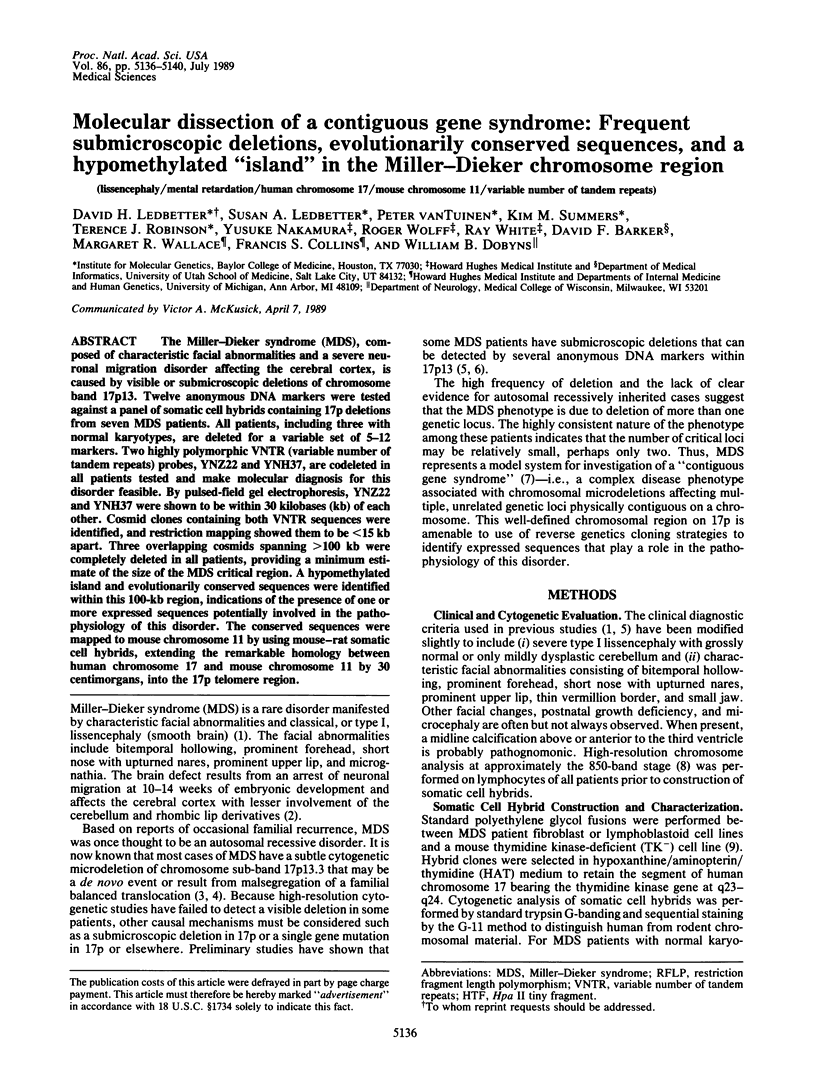
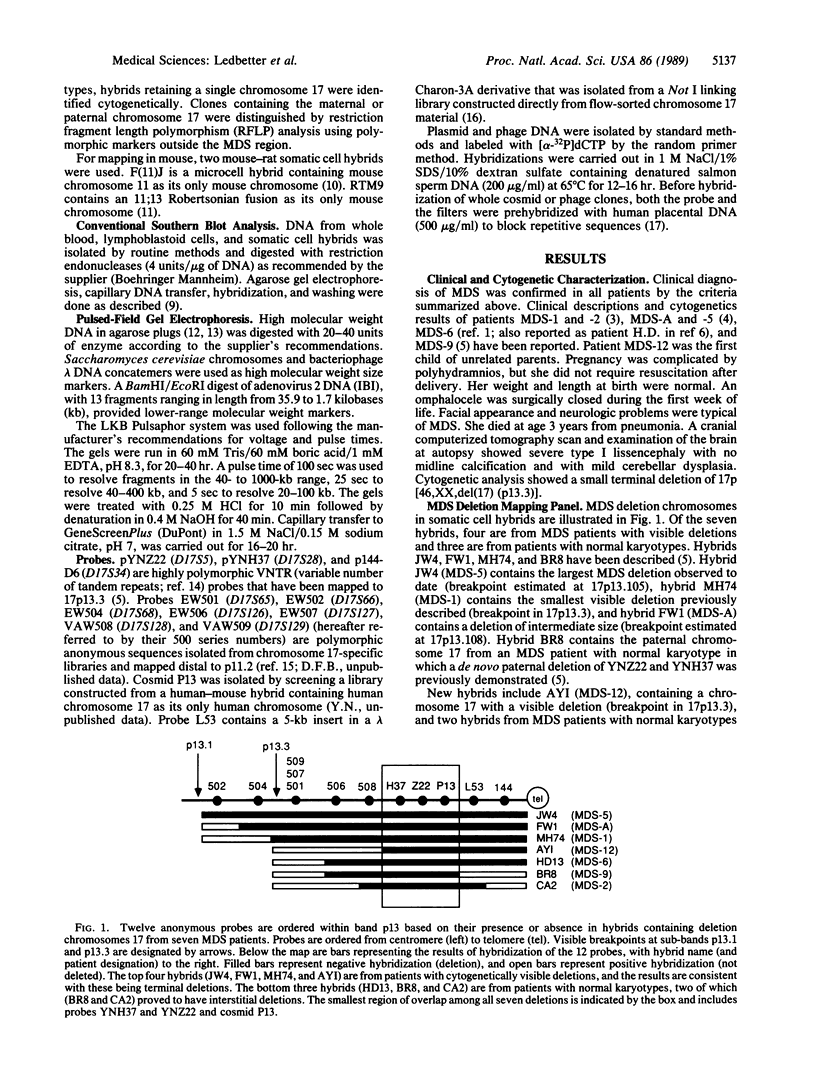
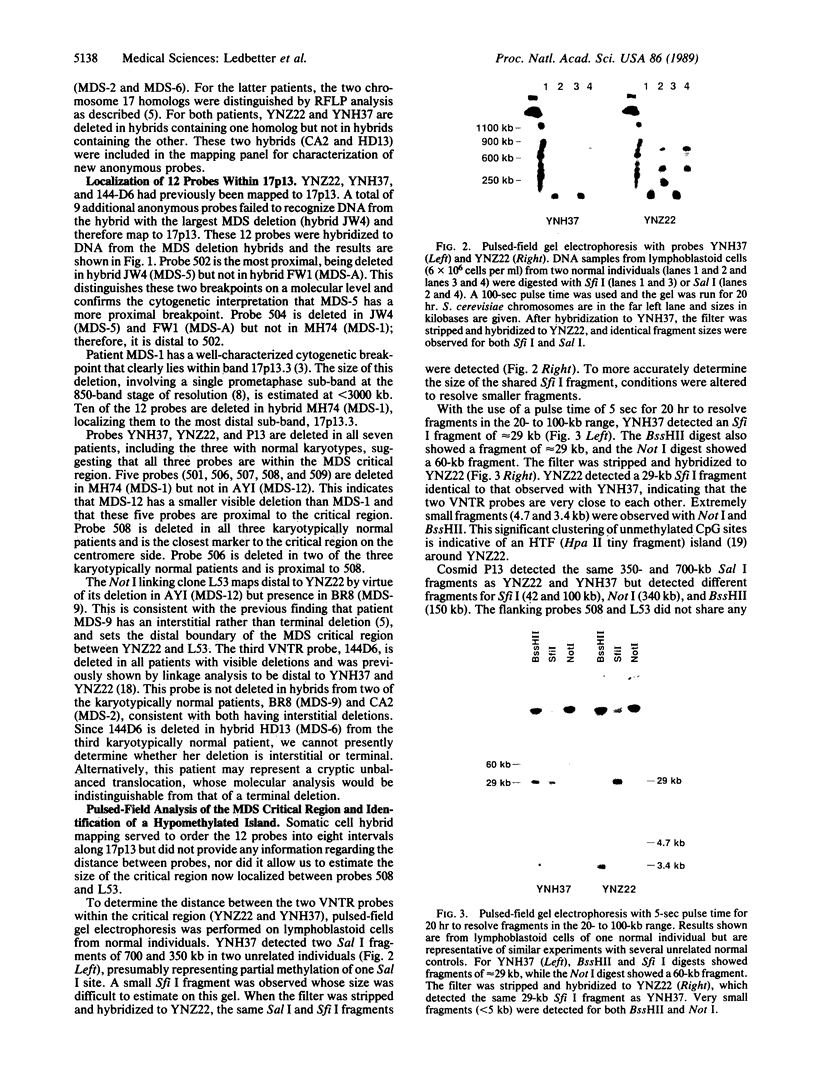
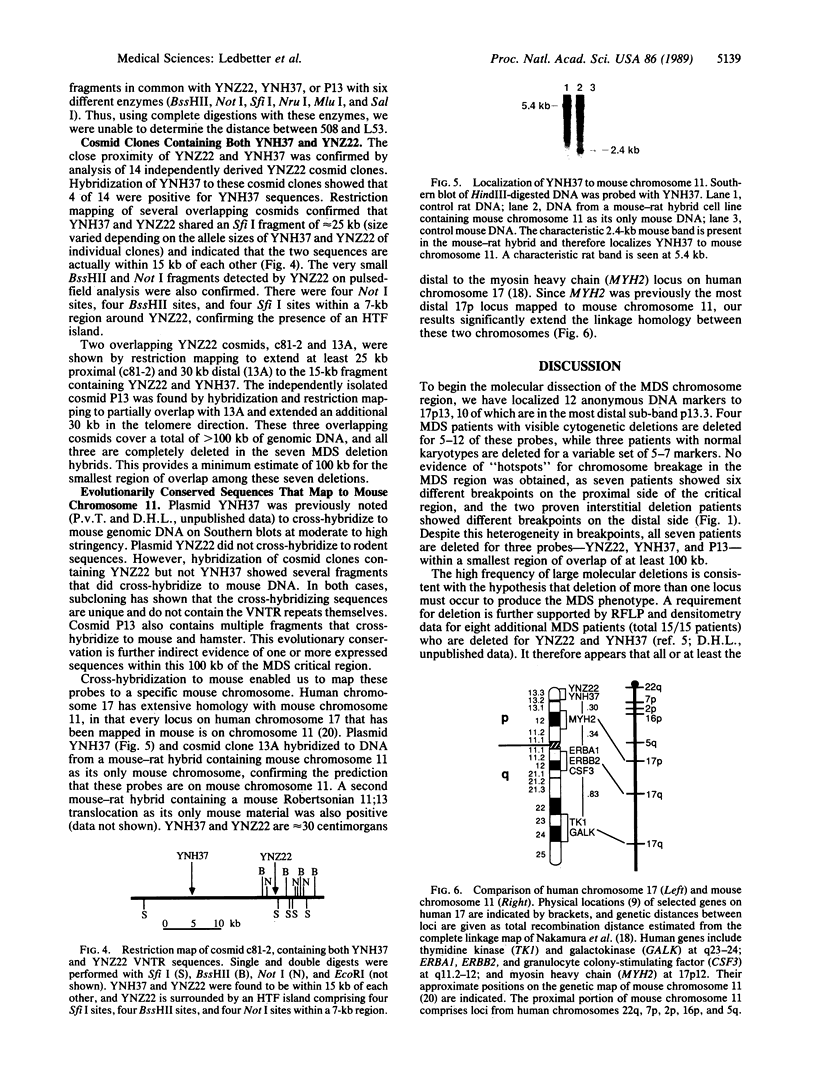
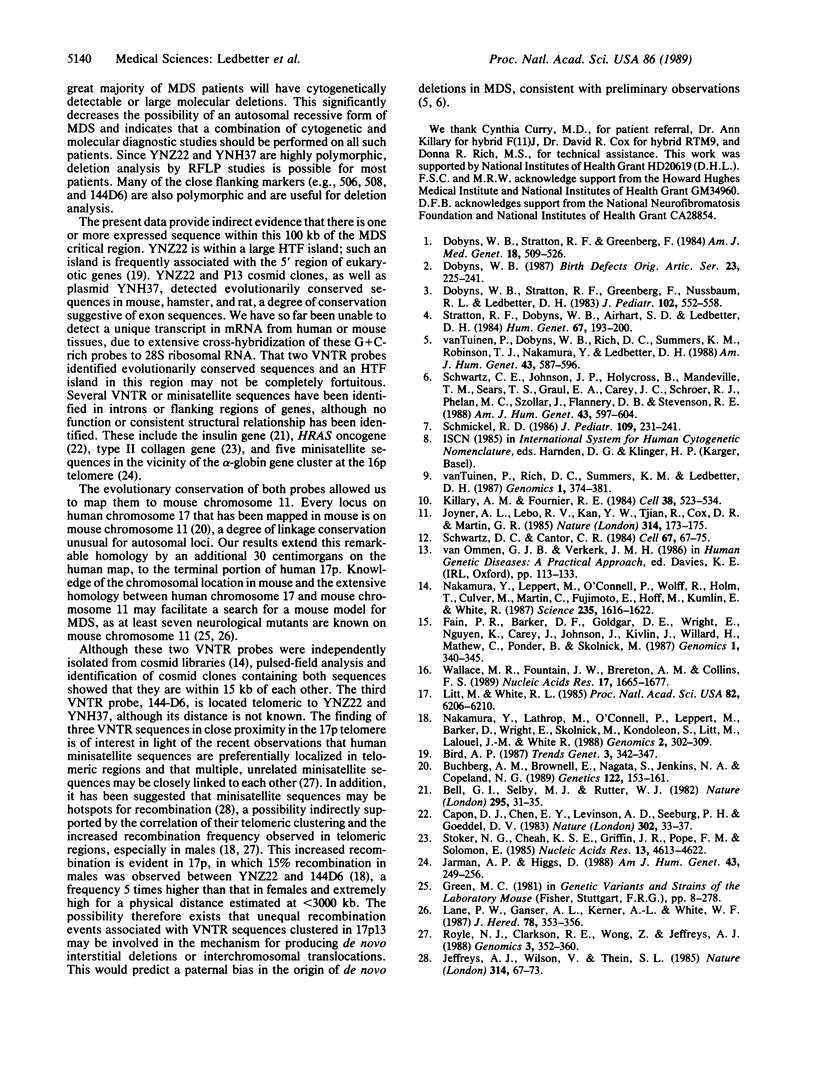
Images in this article
Selected References
These references are in PubMed. This may not be the complete list of references from this article.
- Bell G. I., Selby M. J., Rutter W. J. The highly polymorphic region near the human insulin gene is composed of simple tandemly repeating sequences. Nature. 1982 Jan 7;295(5844):31–35. doi: 10.1038/295031a0. [DOI] [PubMed] [Google Scholar]
- Buchberg A. M., Brownell E., Nagata S., Jenkins N. A., Copeland N. G. A comprehensive genetic map of murine chromosome 11 reveals extensive linkage conservation between mouse and human. Genetics. 1989 May;122(1):153–161. doi: 10.1093/genetics/122.1.153. [DOI] [PMC free article] [PubMed] [Google Scholar]
- Capon D. J., Chen E. Y., Levinson A. D., Seeburg P. H., Goeddel D. V. Complete nucleotide sequences of the T24 human bladder carcinoma oncogene and its normal homologue. Nature. 1983 Mar 3;302(5903):33–37. doi: 10.1038/302033a0. [DOI] [PubMed] [Google Scholar]
- Dobyns W. B. Developmental aspects of lissencephaly and the lissencephaly syndromes. Birth Defects Orig Artic Ser. 1987;23(1):225–241. [PubMed] [Google Scholar]
- Dobyns W. B., Stratton R. F., Greenberg F. Syndromes with lissencephaly. I: Miller-Dieker and Norman-Roberts syndromes and isolated lissencephaly. Am J Med Genet. 1984 Jul;18(3):509–526. doi: 10.1002/ajmg.1320180320. [DOI] [PubMed] [Google Scholar]
- Dobyns W. B., Stratton R. F., Parke J. T., Greenberg F., Nussbaum R. L., Ledbetter D. H. Miller-Dieker syndrome: lissencephaly and monosomy 17p. J Pediatr. 1983 Apr;102(4):552–558. doi: 10.1016/s0022-3476(83)80183-8. [DOI] [PubMed] [Google Scholar]
- Fain P. R., Barker D. F., Goldgar D. E., Wright E., Nguyen K., Carey J., Johnson J., Kivlin J., Willard H., Mathew C. Genetic analysis of NF1: identification of close flanking markers on chromosome 17. Genomics. 1987 Dec;1(4):340–345. doi: 10.1016/0888-7543(87)90034-6. [DOI] [PubMed] [Google Scholar]
- Jarman A. P., Higgs D. R. A new hypervariable marker for the human alpha-globin gene cluster. Am J Hum Genet. 1988 Sep;43(3):249–256. [PMC free article] [PubMed] [Google Scholar]
- Jeffreys A. J., Wilson V., Thein S. L. Hypervariable 'minisatellite' regions in human DNA. Nature. 1985 Mar 7;314(6006):67–73. doi: 10.1038/314067a0. [DOI] [PubMed] [Google Scholar]
- Joyner A. L., Lebo R. V., Kan Y. W., Tjian R., Cox D. R., Martin G. R. Comparative chromosome mapping of a conserved homoeo box region in mouse and human. Nature. 1985 Mar 14;314(6007):173–175. doi: 10.1038/314173a0. [DOI] [PubMed] [Google Scholar]
- Killary A. M., Fournier R. E. A genetic analysis of extinction: trans-dominant loci regulate expression of liver-specific traits in hepatoma hybrid cells. Cell. 1984 Sep;38(2):523–534. doi: 10.1016/0092-8674(84)90507-5. [DOI] [PubMed] [Google Scholar]
- Lane P. W., Ganser A. L., Kerner A. L., White W. F. Spasmodic, a mutation on chromosome 11 in the mouse. J Hered. 1987 Nov-Dec;78(6):353–356. doi: 10.1093/oxfordjournals.jhered.a110414. [DOI] [PubMed] [Google Scholar]
- Litt M., White R. L. A highly polymorphic locus in human DNA revealed by cosmid-derived probes. Proc Natl Acad Sci U S A. 1985 Sep;82(18):6206–6210. doi: 10.1073/pnas.82.18.6206. [DOI] [PMC free article] [PubMed] [Google Scholar]
- Nakamura Y., Lathrop M., O'Connell P., Leppert M., Barker D., Wright E., Skolnick M., Kondoleon S., Litt M., Lalouel J. M. A mapped set of DNA markers for human chromosome 17. Genomics. 1988 May;2(4):302–309. doi: 10.1016/0888-7543(88)90018-3. [DOI] [PubMed] [Google Scholar]
- Nakamura Y., Leppert M., O'Connell P., Wolff R., Holm T., Culver M., Martin C., Fujimoto E., Hoff M., Kumlin E. Variable number of tandem repeat (VNTR) markers for human gene mapping. Science. 1987 Mar 27;235(4796):1616–1622. doi: 10.1126/science.3029872. [DOI] [PubMed] [Google Scholar]
- Royle N. J., Clarkson R. E., Wong Z., Jeffreys A. J. Clustering of hypervariable minisatellites in the proterminal regions of human autosomes. Genomics. 1988 Nov;3(4):352–360. doi: 10.1016/0888-7543(88)90127-9. [DOI] [PubMed] [Google Scholar]
- Schmickel R. D. Contiguous gene syndromes: a component of recognizable syndromes. J Pediatr. 1986 Aug;109(2):231–241. doi: 10.1016/s0022-3476(86)80377-8. [DOI] [PubMed] [Google Scholar]
- Schwartz C. E., Johnson J. P., Holycross B., Mandeville T. M., Sears T. S., Graul E. A., Carey J. C., Schroer R. J., Phelan M. C., Szollar J. Detection of submicroscopic deletions in band 17p13 in patients with the Miller-Dieker syndrome. Am J Hum Genet. 1988 Nov;43(5):597–604. [PMC free article] [PubMed] [Google Scholar]
- Schwartz D. C., Cantor C. R. Separation of yeast chromosome-sized DNAs by pulsed field gradient gel electrophoresis. Cell. 1984 May;37(1):67–75. doi: 10.1016/0092-8674(84)90301-5. [DOI] [PubMed] [Google Scholar]
- Stoker N. G., Cheah K. S., Griffin J. R., Pope F. M., Solomon E. A highly polymorphic region 3' to the human type II collagen gene. Nucleic Acids Res. 1985 Jul 11;13(13):4613–4622. doi: 10.1093/nar/13.13.4613. [DOI] [PMC free article] [PubMed] [Google Scholar]
- Stratton R. F., Dobyns W. B., Airhart S. D., Ledbetter D. H. New chromosomal syndrome: Miller-Dieker syndrome and monosomy 17p13. Hum Genet. 1984;67(2):193–200. doi: 10.1007/BF00273000. [DOI] [PubMed] [Google Scholar]
- Wallace M. R., Fountain J. W., Brereton A. M., Collins F. S. Direct construction of a chromosome-specific NotI linking library from flow-sorted chromosomes. Nucleic Acids Res. 1989 Feb 25;17(4):1665–1677. doi: 10.1093/nar/17.4.1665. [DOI] [PMC free article] [PubMed] [Google Scholar]
- van Tuinen P., Rich D. C., Summers K. M., Ledbetter D. H. Regional mapping panel for human chromosome 17: application to neurofibromatosis type 1. Genomics. 1987 Dec;1(4):374–381. doi: 10.1016/0888-7543(87)90042-5. [DOI] [PubMed] [Google Scholar]
- vanTuinen P., Dobyns W. B., Rich D. C., Summers K. M., Robinson T. J., Nakamura Y., Ledbetter D. H. Molecular detection of microscopic and submicroscopic deletions associated with Miller-Dieker syndrome. Am J Hum Genet. 1988 Nov;43(5):587–596. [PMC free article] [PubMed] [Google Scholar]




